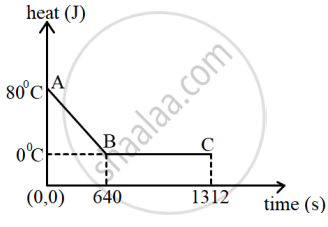Advertisements
Advertisements
प्रश्न
Calculate the ratio of two specific heats of polyatomic gas molecules.
उत्तर
- Gases that have molecules containing more than two atoms are termed polyatomic gases.
- Each molecule of the polyatomic gas has 3 translational degrees of freedom. Only linear molecules have 2 degrees of freedom for rotation. All other polyatomic molecules have 3 degrees of freedom for rotation.
- The number of degrees of freedom (f) for the vibrational motion of a polyatomic molecule depends on the geometric structure of the molecule, i.e., the arrangement of atoms in a molecule.
- Each such degree of freedom contributes average energy `2 xx 1/2`kBT from kinetic energy and potential energy terms.
- Therefore for 1 mole of a polyatomic gas, the internal energy is E = `3/2 N_Ak_BT + 3/2 N_Ak_BT + f × 2/2 N_Ak_BT`
= (3 + f) NAkBT - Molar-specificific heats at constant volume and constant pressure are given as
Cv = (3 + f) R and Cp = (4 + f) R
∴ `gamma = C_p/C_v = (4 + f)/(3 + f)`
संबंधित प्रश्न
What property of water makes it an effective coolant?
Name a liquid which has the highest specific heat capacity.
What do you mean by the following statement?
The specific heat capacity of copper is 0. 4 Jg-1 K-1?
Write the expression for the heat energy Q received by the substance when m kg of substance of specific heat capacity c Jkg-1 k-1 is heated through Δt° C.
Water is used in hot water bottles for fomentation. Give a reason.
Give one example where high specific heat capacity of water is used as heat reservoir ?
A mass m1 of a substance of specific heat capacity c1 at temperature t1 is mixed with a mass m2 of other substance of specific heat capacity c2 at a lower temperature t2. Deduce the expression for the temperature t of the mixture. State the assumption made, if any.
Explain the term boiling point ?
Name two green house gases ?
Name three fossil fuels that emit carbon dioxide into the atmosphere ?
State the impact of global warming on life on the earth.
What impact will global warming have on the health of the affected population?
What impact will climate changes have on the crops of food?
In Regnault's apparatus for measuring specific heat capacity of a solid, there is an inlet and an outlet in the steam chamber. The inlet is near the top and the outlet is near the bottom. Why is it better than the opposite choice where the inlet is near the bottom and the outlet is near the top?
What change in heat energy occurs when lead at its melting point
solidifies without change in the temperature?
State, with reason, which of the two, boiling water or steam both at 100°C will produce more severe burns.
Will the value of specific heat’capacity and specific latent heat of a substance change if the scale is °F instead of °C?
An electric immersion heater is rated 1250 W. Calculate the time in which it will heat 20 kg of water at 5°C to 65°C.
The molar specific heat of a gas at constant volume is 12307.69 J kg-1 K-1. If the ratio of the two specific heats is 1.65, calculate the difference between the two molar specific heats of gas.
All metals have the same specific heat capacity.
Numerical Problem.
What could be the final temperature of a mixture of 100 g of water at 90 °C and 600g of water at 20°C.
Derive Meyer’s relation for an ideal gas.
A monoatomic gas of pressure 'P' having volume 'V' expands isothermally to a volume '2V' and then adiabatically to a volume '16V'. The final pressure of the gas is ______.
(ratio of specific heats = `5/3`)
The diagram below shows a cooling curve for 200 g of water. The heat is extracted at the rate of 100 Js-1. Answer the questions that follow:

- Calculate specific heat capacity of water.
- Heat released in the region BC.
Two metals A and B have specific heat capacities in the ratio 2 : 3. If they are supplied the same amount of heat then
Which metal piece will show a greater rise in temperature given their masses is the same?
Match the following
| 1. | Specific heat capacity | a. | Dewar bottle |
| 2. | Calorimeter | b. | Lavoisier and Simon |
| 3. | Vacuum flask | c. | J Kg-1 K-1 |
| 4. | Ice – calorimeter | d. | Heat capacity |
Find the odd one out:
